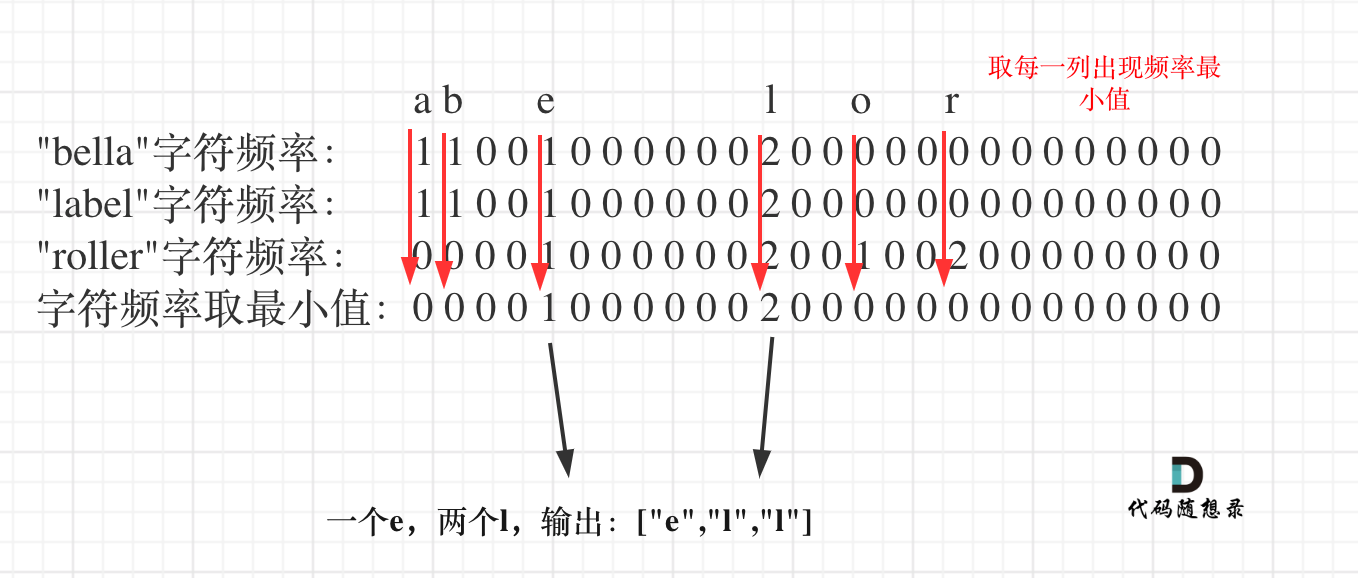参与本项目,贡献其他语言版本的代码,拥抱开源,让更多学习算法的小伙伴们收益!
给你一个字符串数组 words ,请你找出所有在 words 的每个字符串中都出现的共用字符( 包括重复字符),并以数组形式返回。你可以按 任意顺序 返回答案。
示例 1:
输入:words = ["bella","label","roller"] 输出:["e","l","l"] 示例 2:
输入:words = ["cool","lock","cook"] 输出:["c","o"]
提示:
1 <= words.length <= 100 1 <= words[i].length <= 100 words[i] 由小写英文字母组成
这道题意一起就有点绕,不是那么容易懂,其实就是26个小写字符中有字符 在所有字符串里都出现的话,就输出,重复的也算。
例如:
输入:["ll","ll","ll"] 输出:["l","l"]
这道题目一眼看上去,就是用哈希法,“小写字符”,“出现频率”, 这些关键字都是为哈希法量身定做的啊
首先可以想到的是暴力解法,一个字符串一个字符串去搜,时间复杂度是$O(n^m)$,n是字符串长度,m是有几个字符串。
可以看出这是指数级别的时间复杂度,非常高,而且代码实现也不容易,因为要统计 重复的字符,还要适当的替换或者去重。
那我们还是哈希法吧。如果对哈希法不了解,可以看这篇:关于哈希表,你该了解这些!。
如果对用数组来做哈希法不了解的话,可以看这篇:把数组当做哈希表来用,很巧妙!。
了解了哈希法,理解了数组在哈希法中的应用之后,可以来看解题思路了。
整体思路就是统计出搜索字符串里26个字符的出现的频率,然后取每个字符频率最小值,最后转成输出格式就可以了。
如图:
先统计第一个字符串所有字符出现的次数,代码如下:
int hash[26] = {0}; // 用来统计所有字符串里字符出现的最小频率
for (int i = 0; i < A[0].size(); i++) { // 用第一个字符串给hash初始化
hash[A[0][i] - 'a']++;
}接下来,把其他字符串里字符的出现次数也统计出来一次放在hashOtherStr中。
然后hash 和 hashOtherStr 取最小值,这是本题关键所在,此时取最小值,就是 一个字符在所有字符串里出现的最小次数了。
代码如下:
int hashOtherStr[26] = {0}; // 统计除第一个字符串外字符的出现频率
for (int i = 1; i < A.size(); i++) {
memset(hashOtherStr, 0, 26 * sizeof(int));
for (int j = 0; j < A[i].size(); j++) {
hashOtherStr[A[i][j] - 'a']++;
}
// 这是关键所在
for (int k = 0; k < 26; k++) { // 更新hash,保证hash里统计26个字符在所有字符串里出现的最小次数
hash[k] = min(hash[k], hashOtherStr[k]);
}
}此时hash里统计着字符在所有字符串里出现的最小次数,那么把hash转成题目要求的输出格式就可以了。
代码如下:
// 将hash统计的字符次数,转成输出形式
for (int i = 0; i < 26; i++) {
while (hash[i] != 0) { // 注意这里是while,多个重复的字符
string s(1, i + 'a'); // char -> string
result.push_back(s);
hash[i]--;
}
}整体C++代码如下:
class Solution {
public:
vector<string> commonChars(vector<string>& A) {
vector<string> result;
if (A.size() == 0) return result;
int hash[26] = {0}; // 用来统计所有字符串里字符出现的最小频率
for (int i = 0; i < A[0].size(); i++) { // 用第一个字符串给hash初始化
hash[A[0][i] - 'a']++;
}
int hashOtherStr[26] = {0}; // 统计除第一个字符串外字符的出现频率
for (int i = 1; i < A.size(); i++) {
memset(hashOtherStr, 0, 26 * sizeof(int));
for (int j = 0; j < A[i].size(); j++) {
hashOtherStr[A[i][j] - 'a']++;
}
// 更新hash,保证hash里统计26个字符在所有字符串里出现的最小次数
for (int k = 0; k < 26; k++) {
hash[k] = min(hash[k], hashOtherStr[k]);
}
}
// 将hash统计的字符次数,转成输出形式
for (int i = 0; i < 26; i++) {
while (hash[i] != 0) { // 注意这里是while,多个重复的字符
string s(1, i + 'a'); // char -> string
result.push_back(s);
hash[i]--;
}
}
return result;
}
};Java:
class Solution {
public List<String> commonChars(String[] A) {
List<String> result = new ArrayList<>();
if (A.length == 0) return result;
int[] hash= new int[26]; // 用来统计所有字符串里字符出现的最小频率
for (int i = 0; i < A[0].length(); i++) { // 用第一个字符串给hash初始化
hash[A[0].charAt(i)- 'a']++;
}
// 统计除第一个字符串外字符的出现频率
for (int i = 1; i < A.length; i++) {
int[] hashOtherStr= new int[26];
for (int j = 0; j < A[i].length(); j++) {
hashOtherStr[A[i].charAt(j)- 'a']++;
}
// 更新hash,保证hash里统计26个字符在所有字符串里出现的最小次数
for (int k = 0; k < 26; k++) {
hash[k] = Math.min(hash[k], hashOtherStr[k]);
}
}
// 将hash统计的字符次数,转成输出形式
for (int i = 0; i < 26; i++) {
while (hash[i] != 0) { // 注意这里是while,多个重复的字符
char c= (char) (i+'a');
result.add(String.valueOf(c));
hash[i]--;
}
}
return result;
}
}Python
class Solution:
def commonChars(self, words: List[str]) -> List[str]:
if not words: return []
result = []
hash = [0] * 26 # 用来统计所有字符串里字符出现的最小频率
for i, c in enumerate(words[0]): # 用第一个字符串给hash初始化
hash[ord(c) - ord('a')] += 1
# 统计除第一个字符串外字符的出现频率
for i in range(1, len(words)):
hashOtherStr = [0] * 26
for j in range(len(words[i])):
hashOtherStr[ord(words[i][j]) - ord('a')] += 1
# 更新hash,保证hash里统计26个字符在所有字符串里出现的最小次数
for k in range(26):
hash[k] = min(hash[k], hashOtherStr[k])
# 将hash统计的字符次数,转成输出形式
for i in range(26):
while hash[i] != 0: # 注意这里是while,多个重复的字符
result.extend(chr(i + ord('a')))
hash[i] -= 1
return resultPython 3 使用collections.Counter
class Solution:
def commonChars(self, words: List[str]) -> List[str]:
tmp = collections.Counter(words[0])
l = []
for i in range(1,len(words)):
# 使用 & 取交集
tmp = tmp & collections.Counter(words[i])
# 剩下的就是每个单词都出现的字符(键),个数(值)
for j in tmp:
v = tmp[j]
while(v):
l.append(j)
v -= 1
return ljavaScript
var commonChars = function (words) {
let res = []
let size = 26
let firstHash = new Array(size).fill(0) // 初始化 hash 数组
let a = "a".charCodeAt()
let firstWord = words[0]
for (let i = 0; i < firstWord.length; i++) { // 第 0 个单词的统计
let idx = firstWord[i].charCodeAt()
firstHash[idx - a] += 1
}
let otherHash = new Array(size).fill(0) // 初始化 hash 数组
for (let i = 1; i < words.length; i++) { // 1-n 个单词统计
for (let j = 0; j < words[i].length; j++) {
let idx = words[i][j].charCodeAt()
otherHash[idx - a] += 1
}
for (let i = 0; i < size; i++) {
firstHash[i] = Math.min(firstHash[i], otherHash[i])
}
otherHash.fill(0)
}
for (let i = 0; i < size; i++) {
while (firstHash[i] > 0) {
res.push(String.fromCharCode(i + a))
firstHash[i]--
}
}
return res
};GO
func commonChars(words []string) []string {
length:=len(words)
fre:=make([][]int,0)//统计每个字符串的词频
res:=make([]string,0)
//统计词频
for i:=0;i<length;i++{
var row [26]int//存放该字符串的词频
for j:=0;j<len(words[i]);j++{
row[words[i][j]-97]++
}
fre=append(fre,row[:])
}
//查找一列的最小值
for j:=0;j<len(fre[0]);j++{
pre:=fre[0][j]
for i:=0;i<len(fre);i++{
pre=min(pre,fre[i][j])
}
//将该字符添加到结果集(按照次数)
tmpString:=string(j+97)
for i:=0;i<pre;i++{
res=append(res,tmpString)
}
}
return res
}
func min(a,b int)int{
if a>b{
return b
}
return a
}Swift:
func commonChars(_ words: [String]) -> [String] {
var res = [String]()
if words.count < 1 {
return res
}
let aUnicodeScalarValue = "a".unicodeScalars.first!.value
let lettersMaxCount = 26
// 用于统计所有字符串每个字母出现的 最小 频率
var hash = Array(repeating: 0, count: lettersMaxCount)
// 统计第一个字符串每个字母出现的次数
for unicodeScalar in words.first!.unicodeScalars {
hash[Int(unicodeScalar.value - aUnicodeScalarValue)] += 1
}
// 统计除第一个字符串每个字母出现的次数
for idx in 1 ..< words.count {
var hashOtherStr = Array(repeating: 0, count: lettersMaxCount)
for unicodeScalar in words[idx].unicodeScalars {
hashOtherStr[Int(unicodeScalar.value - aUnicodeScalarValue)] += 1
}
// 更新hash,保证hash里统计的字母为出现的最小频率
for k in 0 ..< lettersMaxCount {
hash[k] = min(hash[k], hashOtherStr[k])
}
}
// 将hash统计的字符次数,转成输出形式
for i in 0 ..< lettersMaxCount {
while hash[i] != 0 { // 注意这里是while,多个重复的字符
let currentUnicodeScalarValue: UInt32 = UInt32(i) + aUnicodeScalarValue
let currentUnicodeScalar: UnicodeScalar = UnicodeScalar(currentUnicodeScalarValue)!
let outputStr = String(currentUnicodeScalar) // UnicodeScalar -> String
res.append(outputStr)
hash[i] -= 1
}
}
return res
}C:
//若两个哈希表定义为char数组(每个单词的最大长度不会超过100,因此可以用char表示),可以提高时间和空间效率
void updateHashTable(int* hashTableOne, int* hashTableTwo) {
int i;
for(i = 0; i < 26; i++) {
hashTableOne[i] = hashTableOne[i] < hashTableTwo[i] ? hashTableOne[i] : hashTableTwo[i];
}
}
char ** commonChars(char ** words, int wordsSize, int* returnSize){
//用来统计所有字母出现的最小频率
int hashTable[26] = { 0 };
//初始化返回的char**数组以及返回数组长度
*returnSize = 0;
char** ret = (char**)malloc(sizeof(char*) * 100);
//如果输入数组长度为0,则返回NULL
if(!wordsSize)
return NULL;
int i;
//更新第一个单词的字母频率
for(i = 0; i < strlen(words[0]); i++)
hashTable[words[0][i] - 'a']++;
//更新从第二个单词开始的字母频率
for(i = 1; i < wordsSize; i++) {
//创建新的哈希表,记录新的单词的字母频率
int newHashTable[26] = { 0 };
int j;
for(j = 0; j < strlen(words[i]); j++) {
newHashTable[words[i][j] - 'a']++;
}
//更新原哈希表
updateHashTable(hashTable, newHashTable);
}
//将哈希表中的字符变为字符串放入ret中
for(i = 0; i < 26; i++) {
if(hashTable[i]) {
int j;
for(j = 0; j < hashTable[i]; j++) {
char* tempString = (char*)malloc(sizeof(char) * 2);
tempString[0] = i + 'a';
tempString[1] = '\0';
ret[(*returnSize)++] = tempString;
}
}
}
return ret;
}

